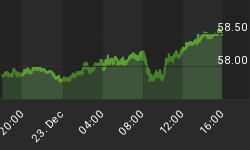Now to the topic that everyone's obsessing over, namely, the price of crude oil. Really, it's all about oil right now. Talk about a momentum market! Oil continues to defy all attempts at keeping it contained within last year's high at the $55 area.
In the March 7 issue of Business Week, the editors ask if the bullish oil market could cause a global economic slowdown and negatively impact the U.S. trade deficit at "just the wrong time." The article was noncommital on whether or not such an oil-related global economic slowdown could happen in the months ahead, although the writers stated "Right now, prospects for such a severe financial dislocation look small," referring to the "wrench" that a rising oil price could throw in the Social Security reform attempt as well as the U.S. stock market.
It is doubtful the editors of one of the largest mainstream financial news magazines would want to rattle their readers by addressing as a front-cover story the potential impacts of the oil bull market on the broad equities market and economy at this point, especially as the major stock market indices are at 3 1/2-year highs. I suspect that will have to wait until well after the effects of a relentless oil price surge and contrived shortages have been manifest for all to see.
 After a brief test of $55.00 on Thursday, March 3 (followed by a sharp pullback), crude oil closed at $53.78 on Friday. The daily chart shows the parabolic bowl formation we've been following the past few months and it allows for the possibility of a run to as high as the $57 area before peaking out.
After a brief test of $55.00 on Thursday, March 3 (followed by a sharp pullback), crude oil closed at $53.78 on Friday. The daily chart shows the parabolic bowl formation we've been following the past few months and it allows for the possibility of a run to as high as the $57 area before peaking out.
This is one of the most unusual parabolic structures I've seen in my years of doing parabolic analysis. Actually, it hearkens back to the late '90s in the stock market when market "corrections" would take on the bowl-shaped pattern with prices bottoming to the left-of-center of the bowl (which is technically bullish and implies the bowl will hold up and take prices to considerable higher levels before finally breaking).
As you can see in the above chart, the latest oil bowl saw price bottom to the left-hand side of the bowls mid-point, or "vertex," back in December-January and since then price has climbed to higher highs without even so much as touching the outer rim of the bowl. Very unusual indeed, and this type of market action is seen only in extreme momentum markets.
I somehow doubt we've seen the last of the oil price rally in the immediate-term. It could be that the lingering upside momentum in the oil market will be blamed for the next peak in the broad stock market. More on this possibility later... For now suffice it say that the 10-week moving average has turned up again, showing the short-term trend to still be up.
Fundamentally, the commercials continue to cover shorts as reflected in the open interest trend. This is bullish in the near-term and combined with the longer-term upside momentum, the price pressure from a rising oil market will eventually start to exert itself against the broad stock market and economy. This lends itself to my earlier forecast of a renewed "micro-mini recession" later this year, of which I'll have more to say in a future commentary.















